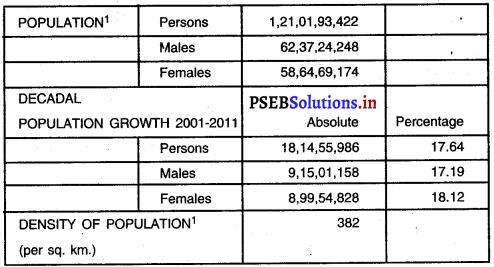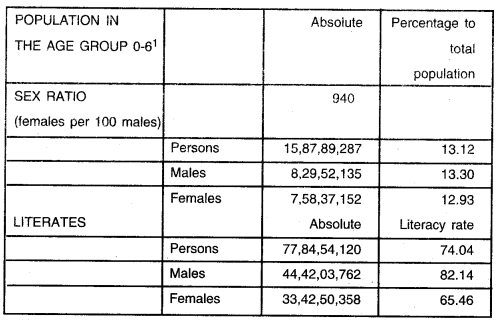This PSEB 12th Class Environmental Education Notes Chapter 13 ਕਾਇਮ ਰਹਿਣਯੋਗ / ਝੱਲਣਯੋਗ / ਟਿਕਾਊ ਖੇਤੀਬਾੜੀ (ਭਾਗ-3) will help you in revision during exams.
PSEB 12th Class Environmental Education Notes Chapter 13 ਕਾਇਮ ਰਹਿਣਯੋਗ / ਝੱਲਣਯੋਗ / ਟਿਕਾਊ ਖੇਤੀਬਾੜੀ (ਭਾਗ-3)
→ ਵਾਤਾਵਰਣੀ ਨਰੋਆਪਨ, ਆਰਥਿਕ ਅਤੇ ਸਮਾਜੀ ਲਾਹੇਵੰਦੀ ਅਤੇ ਆਰਥਿਕ ਨਿਆਂਸੰਗਤੀ (Equity) ਖੇਤੀਬਾੜੀ ਦੇ ਮੁੱਖ ਟੀਚੇ ਹਨ ।
→ ਖੇਤੀ ਕਰਨ ਦੇ ਨਾਲ-ਨਾਲ ਪਸ਼ੂਆਂ ਨੂੰ ਪਾਲਣਾ ਅਤੇ ਰਲੀਆਂ-ਮਿਲੀਆਂ ਫ਼ਸਲਾਂ ਦਾ ਬੀਜਣਾ ਕੁਮਵਾਰ ਮਿਸ਼ਰਿਤ ਕਿਰਸਾਣੀ ਅਤੇ ਮਿਸ਼ਰਿਤ ਖੇਤੀ ਅਖਵਾਉਂਦਾ ਹੈ । ਮਿਸ਼ਰਿਤ ਕਿਰਸਾਣੀ ਦੀ ਵਿਧੀ ਵਿਚ ਮੁੱਖ ਤੌਰ ਤੇ ਪਸ਼ੂਆਂ ਨੂੰ ਰੱਖਿਆ ਅਤੇ ਪਾਲਿਆ ਜਾਂਦਾ ਹੈ ਅਤੇ ਉਨ੍ਹਾਂ ਦੇ ਗੋਹੇ ਦੀ ਵਰਤੋਂ ਫ਼ਸਲਾਂ ਲਈ ਖਾਦ ਵਜੋਂ ਕੀਤੀ ਜਾਂਦੀ ਹੈ ।
→ ਕਿਸਾਨਾਂ ਦੇ ਲਈ ਮਿਸ਼ਰਿਤ ਕਿਰਸਾਣੀ ਲਾਹੇਵੰਦ ਹੁੰਦੀ ਹੈ, ਕਿਉਂਕਿ ਖੇਤੀ ਦੀ ਉਪਜ ਦੇ ਨਾਲ-ਨਾਲ ਕਿਸਾਨਾਂ ਨੂੰ ਆਪਣੇ ਜੀਵਨ-ਨਿਰਬਾਹ ਦੇ ਵਾਸਤੇ ਹੋਰ ਕਈ ਤਰ੍ਹਾਂ ਦੇ ਖਾਧ ਪਦਾਰਥ ਇੱਕੋ ਹੀ ਜਗ੍ਹਾ ਤੋਂ ਪ੍ਰਾਪਤ ਹੋ ਜਾਂਦੇ ਹਨ ।
→ ਇੱਕੋ ਹੀ ਸਮੇਂ ਅਤੇ ਇੱਕੋ ਹੀ ਖੇਤ ਵਿਚ ਦੋ ਜਾਂ ਦੋ ਤੋਂ ਵੱਧ ਫ਼ਸਲਾਂ ਦੇ ਬੀਜਣ ਨੂੰ ਮਿਸ਼ਰਿਤ ਖੇਤੀ ਆਖਦੇ ਹਨ ।

→ ਘੱਟ ਮੀਂਹ ਪੈਣ ਜਾਂ ਨਾ ਪੈਣ ਦੀ ਹਾਲਤ ਵਿਚ ਅੰਤਰ ਖੇਤੀ ਕਰਨ ਨਾਲ ਫ਼ਸਲਾਂ ਨੂੰ ਨੁਕਸਾਨ ਪੁੱਜਣ ਦਾ ਖਤਰਾ ਘੱਟ ਜਾਂਦਾ ਹੈ, ਕਿਉਂਕਿ ਕੁੱਝ ਫ਼ਸਲਾਂ ਅਜਿਹੀ ਹਾਲਤ ਵਿਚ ਵੀ ਉਗ ਪੈਂਦੀਆਂ ਹਨ, ਅਤੇ ਇਸ ਤਰ੍ਹਾਂ ਕਿਸਾਨਾਂ ਦਾ ਆਰਥਿਕ ਨੁਕਸਾਨ ਨਹੀਂ ਹੁੰਦਾ ।
→ ਇੱਕੋ ਹੀ ਖੇਤ ਵਿਚ ਕਤਾਰਾਂ ਵਿਚ ਦੋ ਜਾਂ ਦੋ ਤੋਂ ਜ਼ਿਆਦਾ ਫ਼ਸਲਾਂ ਉਗਾਉਣ ਨੂੰ ਅੰਤਰ ਖੇਤੀ (Inter Cropping) ਆਖਦੇ ਹਨ । ਕਤਾਰਾਂ ਬਣਾਉਣ ਸਮੇਂ ਖ਼ਾਸ ਕਿਸਮ ਦੇ ਤਰੀਕੇ ਵਰਤੇ ਜਾਂਦੇ ਹਨ । ਬੀਜੀਆਂ ਗਈਆਂ ਫ਼ਸਲਾਂ ਵਿਚੋਂ ਇਕ ਫ਼ਸਲ ਪ੍ਰਭਾਵੀ (Dominant) ਹੁੰਦੀ ਹੈ, ਜਦ ਕਿ ਦੂਸਰੀ ਕਤਾਰ ਵਾਲੀ ਫ਼ਸਲ ਨੂੰ ਅੰਤਰ ਫ਼ਸਲ ਆਖਦੇ ਹਨ ।
→ ਅੰਤਰ ਖੇਤੀ ਕਰਨ ਵਾਲੀਆਂ ਫ਼ਸਲਾਂ ਦੀ ਖਾਦਾਂ ਸੰਬੰਧੀ ਲੋੜਾਂ ਅਲੱਗ-ਅਲੱਗ ਹੋਣ ਕਾਰਨ, ਭਾਂ ਦੀ ਸਮੁੱਚੀ ਉਪਜਾਊ ਸ਼ਕਤੀ ਉੱਤੇ ਕੋਈ ਵਿਸ਼ੇਸ਼ ਫਰਕ ਨਹੀਂ ਪੈਂਦਾ । ਅਤੇ ਉਪਜਾਊ ਸ਼ਕਤੀ ਕਾਇਮ ਰਹਿੰਦੀ ਹੈ ।
→ ਅੰਤਰ ਫ਼ਸਲੀ ਖੇਤੀ ਕਰਨ ਨਾਲ ਥਾਂ ਦੀ ਬੱਚਤ ਵੀ ਹੋ ਜਾਂਦੀ ਹੈ ਅਤੇ ਦੋ ਤੋਂ ਵੱਧ ਫ਼ਸਲਾਂ ਦੀ ਕਾਸ਼ਤ ਕਰਨ ਨਾਲ ਸਮੇਂ ਦੀ ਬੱਚਤ ਵੀ ਹੁੰਦੀ ਹੈ ।
→ ਫ਼ਸਲੀ ਚੱਕਰ (Crop rotation) ਫ਼ਸਲੀ ਚੱਕਰ ਇਕ ਅਜਿਹੀ ਵਿਧੀ ਹੈ ਜਿਸ ਵਿਚ ਵੱਖ-ਵੱਖ ਤਰ੍ਹਾਂ ਦੀਆਂ ਫ਼ਸਲਾਂ ਨੂੰ ਬਦਲ-ਬਦਲ ਕੇ ਬੀਜਿਆ ਜਾਂਦਾ ਹੈ । ਇੱਕੋ ਹੀ ਖੇਤ ਵਿਚ ਬਦਲ-ਬਦਲ ਕੇ ਫਸਲਾਂ ਦੀ ਕਾਸ਼ਤ ਫ਼ਸਲੀ ਚੱਕਰ ਅਖਵਾਉਂਦੀ ਹੈ ।
→ ਜ਼ਮੀਨ ਵਿਚ ਪੌਸ਼ਟਿਕ ਪਦਾਰਥਾਂ, ਵਿਸ਼ੇਸ਼ ਕਰਕੇ ਨਾਈਟ੍ਰੋਜਨ ਅਤੇ ਕਾਰਬਨੀ ਪਦਾਰਥਾਂ ਦੀ ਮਾਤਰਾ ਵਧਾਉਣ ਦੇ ਮੰਤਵ ਨਾਲ ਫਲੀਦਾਰ ਪੌਦਿਆਂ ਦੀ ਬੀਜਾਈ ਕੀਤੀ ਜਾਂਦੀ ਹੈ । ਅਜਿਹਾ ਕਰਨ ਦੇ ਵਾਸਤੇ ਹਰੀ ਖਾਦ ਦੇਣ ਵਾਲੇ ਪੌਦਿਆਂ ਦੀ ਬੀਜਾਈ ਵੀ ਕੀਤੀ ਜਾਂਦੀ ਹੈ ।
→ ਬਨਾਉਟੀ ਖਾਦਾਂ ਬੜੀਆਂ ਨੁਕਸਾਨਦਾਇਕ ਹਨ, ਕਿਉਂਕਿ ਖੇਤਾਂ ਵਿਚੋਂ ਪਾਣੀ ਦੇ ਨਾਲ ਵਹਿ ਕੇ ਰੁੜ ਕੇ ਇਹ ਖਾਦਾਂ ਜਲ ਸਰੋਤਾਂ ਨੂੰ ਪ੍ਰਦੂਸ਼ਿਤ ਕਰ ਦਿੰਦੀਆਂ ਹਨ । ਜੀਵ ਨਾਸ਼ਕਾਂ ਦਾ ਇਕੱਤਰਣ ਅਤੇ ਜ਼ਿਆਦਾ ਸੰਘਣਤਾ ਦੇ ਕਾਰਨ ਵਾਤਾਵਰਣ ਵਿਚ ਕਈ ਪ੍ਰਕਾਰ ਦੇ ਸੰਕਟ ਪੈਦਾ ਹੋ ਜਾਂਦੇ ਹਨ, ਜਿਹੜੇ ਕਿ ਜਾਨਵਰਾਂ ਅਤੇ ਮਨੁੱਖਾਂ ਲਈ ਨੁਕਸਾਨਦਾਇਕ ਸਿੱਧ ਹੁੰਦੇ ਹਨ ।
→ ਰਸਾਇਣਿਕ ਖਾਦਾਂ ਦੀ ਤਿਆਰੀ ਕਰਨ ਦੇ ਵਾਸਤੇ ਊਰਜਾ ਦੀ ਬਹੁਤ ਜ਼ਿਆਦਾ ਜ਼ਰੂਰਤ ਪੈਂਦੀ ਹੈ । ਖਾਦ ਦੀ ਇਕ ਇਕਾਈ ਨੂੰ ਤਿਆਰ ਕਰਨ ਦੇ ਵਾਸਤੇ ਅੰਦਾਜ਼ਨ ਪਥਰਾਟ ਈਂਧਨ ਦੀਆਂ ਦੋ ਇਕਾਈਆਂ (Units) ਦੀ ਲੋੜ ਹੁੰਦੀ ਹੈ ।

→ ਜ਼ਿਆਦਾਤਰ ਰਸਾਇਣਿਕ ਜੀਵਨਾਸ਼ਕ ਨਿਸ਼ਚਿਤ (Specific) ਨਹੀਂ ਹੁੰਦੇ ਹਨ । ਇਸ ਦੇ ਇਲਾਵਾ ਜੀਵਾਂ ਵਿਚ ਖ਼ਾਸ ਕਿਸਮ ਦੇ ਜੀਵਨਾਸ਼ਕ ਦੇ ਵਿਰੁੱਧ ਟਾਕਤ੍ਰਾ ਕਰਨ ਦੀ ਸਮਰੱਥਾ ਉਤਪੰਨ ਹੋ ਜਾਂਦੀ ਹੈ । ਜੀਵਨਾਸ਼ਕਾਂ ਦੀ ਬੇਸਮਝੀ ਨਾਲ ਵਰਤੋਂ ਕਰਨ ਨਾਲ ਕਈ ਵਾਰ ਜੀਵਾਂ ਦੀਆਂ ਨਵੀਆਂ ਕਿਸਮਾਂ ਵੀ ਪੈਦਾ ਹੋ ਜਾਂਦੀਆਂ ਹਨ । ਇਸ ਲਈ ਕੀਟਨਾਸ਼ਕਾਂ ਦੀ ਵਰਤੋਂ ਬਦਲ-ਬਦਲ ਕੇ ਕਰਨੀ ਚਾਹੀਦੀ ਹੈ ਤਾਂ ਜੋ ਇਨ੍ਹਾਂ ਜੀਵਨਾਸ਼ਕਾਂ ਦਾ ਪ੍ਰਭਾਵ ਕਾਇਮ ਰਹੇ ।
* ਬਨਾਉਟੀ ਖਾਦਾਂ ਅਤੇ ਜੀਵਨਾਸ਼ਕਾਂ ਦੇ ਬਣਾਉਣ ਅਤੇ ਪ੍ਰਬੰਧਣ ਦੇ ਸਮੇਂ ਕਈ ਤਰ੍ਹਾਂ ਦੇ ਪ੍ਰਦੂਸ਼ਣ ਪੈਦਾ ਹੋ ਜਾਂਦੇ ਹਨ, ਜਿਹੜੇ ਫ਼ਸਲਾਂ ਅਤੇ ਮਿੱਟੀ ਨੂੰ ਨਸ਼ਟ ਕਰਨ ਦੇ ਇਲਾਵਾ ਵਾਤਾਵਰਣ ਨੂੰ ਵੀ ਨੁਕਸਾਨ ਪਹੁੰਚਾਉਂਦੇ ਹਨ ।
→ ਦੇਸੀ ਖਾਦ/ਰੂੜੀ (Manure) ਸੰਪੂਰਨ ਤੌਰ ਤੇ ਵਿਘਟਿਤ ਹੋਇਆ ਕਾਰਬਨੀ ਪਦਾਰਥ ਹੈ । ਇਸ ਦੀ ਵਰਤੋਂ ਕਰਨ ਨਾਲ ਨਾ ਕੇਵਲ ਮਿੱਟੀ ਦੀ ਉਪਜਾਊ
ਸ਼ਕਤੀ ਵਿਚ ਵਾਧਾ ਹੀ ਹੁੰਦਾ ਹੈ ਸਗੋਂ ਉਤਪਾਦਕਤਾ ਵਿਚ ਵੀ ਧੀ ਹੁੰਦੀ ਹੈ । ਰੂੜੀ ਖਾਦਾਂ ਵਿਚ ਉਹ ਸਾਰੇ ਪੌਸ਼ਟਿਕ ਪਦਾਰਥ ਮੌਜੂਦ ਹੁੰਦੇ ਹਨ ਜਿਨ੍ਹਾਂ ਦੀ ਪੌਦਿਆਂ
ਨੂੰ ਲੋੜ ਹੁੰਦੀ ਹੈ ।
→ ਦੇਸੀ ਖਾਦ/ਰੂੜੀ ਖਾਦ ਦੀਆਂ ਤਿੰਨ ਕਿਸਮਾਂ-
- ਡੰਗਰਾਂ ਦੇ ਵਾੜੇ ਦੀ ਖਾਦ (Farm Yard Manure)
- ਬਨਸਪਤੀ ਖਾਦ (Compost) ਅਤੇ
- ਹਰੀ ਖਾਦ (Green Manure) ਹਨ ।
→ ਜੀਵ-ਫਰਟੀਲਾਈਜ਼ਰਜ਼ (Biofertilizers) ਨੂੰ ਬਹੁਤ ਚੰਗਾ ਮੰਨਿਆ ਗਿਆ ਹੈ, ਕਿਉਂਕਿ ਇਹ ਜਲਵਾਯੂ ਦਾ ਪ੍ਰਦੂਸ਼ਣ ਨਹੀਂ ਕਰਦੇ । ਇਹ ਫਰਟੀਲਾਈਜ਼ਰ ਸਸਤੇ ਅਤੇ ਆਰਥਿਕ ਪੱਖੋਂ ਸੰਜਮੀ ਵੀ ਹਨ । ਇਨ੍ਹਾਂ ਖਾਦਾਂ ਦੀ ਵਰਤੋਂ ਗ਼ਰੀਬ ਕਿਸਾਨ ਵੀ ਕਰ ਸਕਦੇ ਹਨ ।
→ ਜਿਨ੍ਹਾਂ ਜ਼ਹਿਰੀਲੇ ਰਸਾਇਣਿਕ ਪਦਾਰਥਾਂ ਨੂੰ ਹਾਨੀਕਾਰਕ ਜੀਵਾਂ ਨੂੰ ਨਸ਼ਟ ਕਰਨ ਦੇ ਲਈ ਅਤੇ ਲਾਹੇਵੰਦ ਪੌਦਿਆਂ ਦੇ ਬਚਾਉਣ ਲਈ ਵਰਤੇ ਜਾਂਦੇ ਹਨ, ਉਨ੍ਹਾਂ ਪਦਾਰਥਾਂ ਨੂੰ ਜੀਵਨਾਸ਼ਕ (Pesticides) ਆਖਦੇ ਹਨ ।
→ ਬਾਇਓ ਪੈਸਟੀਸਾਈਡਜ਼-ਇਹ ਅਜਿਹੇ ਨਾਸ਼ਕ ਹਨ ਜਿਨ੍ਹਾਂ ਦੀ ਵਰਤੋਂ ਨਦੀਨਾਂ ਅਤੇ ਨੁਕਸਾਨ ਕਰਨ ਵਾਲੇ ਜੀਵਾਂ ਨੂੰ ਕੰਟਰੋਲ ਕਰਨ ਲਈ ਕੀਤੀ ਜਾਂਦੀ ਹੈ ।
→ ਬਾਇਓ ਪੈਸਟੀਸਾਈਡਜ਼ ਦੋ ਤਰ੍ਹਾਂ ਦੇ ਹਨ-
- ਜੀਵ ਨਦੀਨਨਾਸ਼ਕ (Bioher bicides) ਅਤੇ
- ਜੀਵ ਕੀਟ ਨਾਸ਼ਕ (Bio-insecticides)
→ ਨਦੀਨਾਂ ਅਤੇ ਹਾਨੀਕਾਰਕ ਕੀਟਾਂ ਆਦਿ ‘ਤੇ ਕੰਟਰੋਲ ਕਰਨ ਵਾਸਤੇ ਬਾਇਓ ਪੈਸਟੀਸਾਈਡਜ਼ ਦੀ ਵਰਤੋਂ ਨਾ ਕੇਵਲ ਵਧੇਰੇ ਪ੍ਰਭਾਵਸ਼ਾਲੀ ਹੀ ਹੈ, ਸਗੋਂ ਇਸ ਦੀ ਵਰਤੋਂ ਬੜੀ ਸੰਜਮੀ ਵੀ ਹੈ । ਇਹ ਕਿਸੇ ਵੀ ਤਰ੍ਹਾਂ ਨਾਲ ਪ੍ਰਦੂਸ਼ਣ ਨਹੀਂ ਫੈਲਾਉਂਦੇ ।
→ ਨਦੀਨਾਂ ਤੇ ਨਿਯੰਤਰਨ ਕਰਨ ਦੇ ਵਾਸਤੇ ਤੇ ਉੱਲੀਆਂ, ਬੈਕਟੀਰੀਆ, ਗੋਲ ਕਰਮ (Nematodes) ਆਦਿ ਜੀਵਾਂ, ਜਿਹੜੇ ਕਿ ਨਦੀਨਾਂ ਨੂੰ ਜਾਂ ਤਾਂ ਦਬਾ ਦਿੰਦੇ ਹਨ ਜਾਂ ਨਸ਼ਟ ਕਰ ਦਿੰਦੇ ਹਨ, ਦੀ ਵਰਤੋਂ ਕੀਤੀ ਜਾਂਦੀ ਹੈ । ਇਨ੍ਹਾਂ ਪਦਾਰਥਾਂ ਦੀ ਵਰਤੋਂ ਕਰਨ ਦੇ ਨਾਲ ਫ਼ਸਲਾਂ ਆਦਿ ਨੂੰ ਕੋਈ ਨੁਕਸਾਨ ਨਹੀਂ ਪਹੁੰਚਦਾ ।

→ ਕਿਸੇ ਵੀ ਜੈਵਿਕ ਏਜੰਟ (Biological agent) ਤੋਂ ਪ੍ਰਾਪਤ ਕੀਤੇ ਜਾਣ ਵਾਲੇ ਰਸਾਇਣ ਨਦੀਨਾਂ ਅਤੇ ਕੀਟਾਂ ਉੱਤੇ ਪ੍ਰਭਾਵ ਪਾਉਂਦੇ ਹਨ । ਜਿਹੜੇ ਬਾਇਓ ਸਾਈਡਜ਼, ਨਰਮ ਤਣਿਆਂ ਵਾਲੀਆਂ ਨਦੀਨਾਂ (Herbs) ਨੂੰ ਨਸ਼ਟ ਕਰਨ, ਉਨ੍ਹਾਂ ਨੂੰ ਨਦੀਨਨਾਸ਼ਕ ਆਖਦੇ ਹਨ ਅਤੇ ਜਿਹੜੇ ਬਾਇਓ ਪੈਸਟੀਸਾਈਡਜ਼ ਕੀਟਾਂ ਨੂੰ ਨਸ਼ਟ ਕਰਦੇ ਹਨ, ਉਨ੍ਹਾਂ ਨੂੰ ਬਾਇਓ ਕੀਟਨਾਸ਼ਕ ਕਹਿੰਦੇ ਹਨ ।
→ ਸਥਾਨਕ ਉੱਲੀ ਦੀ ਵਰਤੋਂ ਕਰਕੇ ਜਲਕੁੰਭੀ (Water Hyacinth) ਨੂੰ ਨਿਯੰਤ੍ਰਿਤ ਕੀਤਾ ਜਾ ਸਕਦਾ ਹੈ ।
→ ਏਵਿਡਜ਼/ਤੇਲਾ (Aphids) ਆਦਿ ਵਰਗੇ ਪਰਜੀਵੀਆਂ ਨੂੰ ਕਾਬੂ ਕਰਨ ਅਤੇ ਨਿਯੰਤ੍ਰਿਤ ਕਰਨ ਦੇ ਲਈ ਪੇਇੰਗ ਮੈਂਟਸ (Prey Mantis) ਅਤੇ ਲੇਡੀ ਬੱਗਜ਼ (Lady bugs) ਦੀ ਵਰਤੋਂ ਕਰਨ ਦੇ ਸਫਲ ਨਤੀਜੇ ਨਿਕਲਦੇ ਹਨ । ਹਾਨੀਕਾਰਕ ਕੀਟਾਂ ਆਦਿ ਤੇ ਕੰਟਰੋਲ ਦੇ ਵਾਸਤੇ ਅਤੇ ਨਸ਼ਟ ਕਰਨ ਦੇ ਲਈ ਕੁਦਰਤੀ
ਪਰਜੀਵੀਆਂ ਦੀ ਵਰਤੋਂ ਕੀਤੀ ਜਾ ਸਕਦੀ ਹੈ ।
→ ਨਰ ਕੀਟਾਂ ਆਦਿ ਨੂੰ ਬੇਪੈਦ/ਨਪੁੰਸਕ (Sterilize) ਕਰਨ ਵਾਸਤੇ ਵਿਕੀਰਣਾਂ (Irradiation) ਦੀ ਵਰਤੋਂ ਕੀਤੀ ਜਾ ਸਕਦੀ ਹੈ । ਜਦੋਂ ਨਦੀਨ ਕੀਟ ਅਜਿਹੇ ਨਰਾਂ ਨਾਲ ਸੰਭੋਗ ਕਰਦੇ ਹਨ, ਤਾਂ ਇਹ ਸੰਤਾਨ ਪੈਦਾ ਨਹੀਂ ਕਰ ਸਕਦੇ ।
→ ਕੀਟਾਂ ਨੂੰ ਆਪਣੇ ਵੱਲ ਆਕਰਸ਼ਿਤ ਕਰਨ ਅਤੇ ਸੂਚਨਾਵਾਂ ਆਦਿ ਦੇ ਸੰਚਾਰਨ ਲਈ ਵਰਤੇ ਜਾਂਦੇ ਰਸਾਊ (Secretions) ਨੂੰ ਫੇਰੋਮੋਨਜ਼ (Pheromones) ਕਹਿੰਦੇ ਹਨ । ਇਹ ਰਸਾਇਣ ਕੇਵਲ ਨਨ ਕੀਟ ਹੀ ਪੈਦਾ ਕਰਦੇ ਹਨ, ਜਿਨ੍ਹਾਂ ਦੀ ਪਹਿਚਾਨ ਨਰ ਕੀਟ ਕਰ ਲੈਂਦੇ ਹਨ । ਇਹ ਰਸਾਇਣ ਜਾਤੀ ਨਿਸ਼ਚਿਤ ਹਨ ।
→ ਹਾਨੀਕਾਰਕ ਕੀਟਾਂ ਦੀ ਪੈਦਾਇਸ਼ ‘ਤੇ ਕੰਟਰੋਲ ਕਰਨ ਦੇ ਵਾਸਤੇ ਨਰ ਨੂੰ ਆਕਰਸ਼ਿਤ ਕਰਨ ਵਾਲੇ ਫੇਰੋਮੋਨਜ਼ ਦੀ ਵਰਤੋਂ ਕੀਤੀ ਜਾ ਸਕਦੀ ਹੈ ।
→ ਪੌਦਿਆਂ ਤੋਂ ਪ੍ਰਾਪਤ ਹੋਣ ਵਾਲੇ ਕੁਦਰਤੀ, ਕੀਟਨਾਸ਼ਕ ਘੱਟ ਜ਼ਹਿਰੀਲੇ ਅਤੇ ਜੀਵ ਵਿਘਟਨਸ਼ੀਲ ਹੁੰਦੇ ਹਨ, ਜਿਵੇਂ ਕਿ ਐਲਕੇਲਾਇਡ (Alkaloids) ਤੰਮਾਕੂ (ਇਕ ਕੁਦਰਤੀ ਕੀਟਨਾਸ਼ਕ ਹਨ) । ਨਿੰਮ ਤੋਂ ਪ੍ਰਾਪਤ ਕੀਤਾ ਗਿਆ ਪਦਾਰਥ ਕੀਟਾਂ ਨੂੰ ਅਪਕਰਸ਼ਿਤ (Repel) ਕਰਨ ਦੇ ਨਾਲ-ਨਾਲ ਉਨ੍ਹਾਂ ਨੂੰ ਨਸ਼ਟ ਵੀ ਕਰ ਦਿੰਦਾ ਹੈ ।
→ ਹਾਨੀਕਾਰਕ ਜੀਵਾਂ ਨੂੰ ਨਸ਼ਟ ਕਰਨ ਦੇ ਮੰਤਵ ਨਾਲ ਕਈ ਪ੍ਰਕਾਰ ਦੇ ਕੀਟਨਾਸ਼ਕਾਂ ਦੀ ਸਮਝਦਾਰੀ ਨਾਲ ਵਰਤੋਂ ਕਰਨ ਨਾਲ ਵਾਤਾਵਰਣੀ ਪ੍ਰਦੂਸ਼ਣ ਬਹੁਤ ਹੀ ਘੱਟ ਹੁੰਦਾ ਹੈ ਅਤੇ ਪਰਿਸਥਿਤਿਕ ਪ੍ਰਬੰਧਾਂ ਨੂੰ ਵੀ ਠੀਕ ਤਰ੍ਹਾਂ ਕਾਇਮ ਰੱਖਿਆ ਜਾ ਸਕਦਾ ਹੈ ।
→ ਜੀਵਾਂ ਦੇ ਏਕੀਕ੍ਰਿਤ ਪ੍ਰਬੰਧਣ ਪ੍ਰੋਗਰਾਮ (Integrated Pest Management Programme) ਦਾ ਇਹ ਮੁੱਖ ਮੰਤਵ ਵੀ ਹੈ ।
→ ਹਾਨੀਕਾਰਕ ਜੀਵਾਂ ਨੂੰ ਨਸ਼ਟ ਕਰਨ ਵਾਲੇ ਜ਼ਹਿਰੀਲੇ ਪਦਾਰਥ ਮਨੁੱਖਾਂ ਅੰਦਰ ਦਮਾ ਅਤੇ ਕਈ ਤਰ੍ਹਾਂ ਦੇ ਚਰਮ ਰੋਗ, ਜਿਗਰ ਦੀਆਂ ਬਿਮਾਰੀਆਂ ਅਤੇ ਮਾਨਸਿਕ ਗੁੰਝਲਾਂ ਪੈਦਾ ਕਰ ਸਕਦੇ ਹਨ ।
→ ਜ਼ਰਾਇਤੀ ਉਪਜ ਵਧਾਉਣ ਦੇ ਮੰਤਵ ਨਾਲ ਡੀ. ਐੱਨ. ਏ. (D.N.A.) ਵਿਚ ਸੋਧ ਕਰਨ ਦੇ ਲਈ ਵਰਤੀਆਂ ਜਾਂਦੀਆਂ ਤਕਨੀਕਾਂ ਦਾ ਸੰਬੰਧ ਬਾਇਓ ਤਕਨਾਲੋਜੀ ਨਾਲ ਹੈ ।

→ DNA ਫ਼ਸਲਾਂ ਅਤੇ ਪਸ਼ੂ ਧਨ ਦਾ ਜਣਨਿਕ ਪਦਾਰਥ ਹੈ ਅਤੇ ਇਸ ਵਿਚ ਸੋਧ ਕਰਨ ਦਾ ਉਦੇਸ਼ ਫ਼ਸਲਾਂ ਅਤੇ ਪਸ਼ੂ ਧਨ ਵਿਚ ਹਾਨੀਕਾਰਕ ਕੀਟਾਂ ਅਤੇ ਬੀਮਾਰੀਆਂ ਨੂੰ ਸਹਾਰਨ ਦੀ ਸਮਰੱਥਾ ਪੈਦਾ ਕਰਨਾ ਅਤੇ ਉਤਪਾਦਨ ਵਿਚ ਵਾਧਾ ਕਰਨਾ ਅਤੇ ਇਨ੍ਹਾਂ ਫ਼ਸਲਾਂ ਅਤੇ ਪਸ਼ੂ ਧਨ ਦੇ ਗੁਣਾਂ ਵਿਚ ਵਿਧੀ ਹੈ । ਅਜਿਹੇ ਪੌਦਿਆਂ ਆਦਿ ਨੂੰ ਜਨਿਕ ਤੌਰ ਤੇ ਸੁਧਾਰੇ ਗਏ ਸਜੀਵ (Genetically Modified Organism GMO’s) ਆਖਦੇ ਹਨ ।
→ ਜਿਹੜੇ ਵੀ ਸਧਰੇ ਹੋਏ ਪੌਦਿਆਂ ਦਾ ਵਿਕਾਸ ਹੋਇਆ ਹੈ, ਉਸ ਦੀ ਆਮ ਵਜ਼ਾ ਬਾਇਓ ਤਕਨਾਲੋਜੀ ਹੀ ਹੈ । ਅਜਿਹੇ ਪੌਦੇ ਬੀਮਾਰੀਆਂ ਨੂੰ ਸਹਾਰ ਸਕਦੇ ਹਨ, ਟਾਕਰਾ ਕਰ ਸਕਦੇ ਹਨ ਅਤੇ ਇਹ ਪੌਦੇ ਨਦੀਨਾਂ ਅਤੇ ਹਾਨੀਕਾਰਕ ਕੀਟਾਂ ਆਦਿ ਤੋਂ ਵੀ ਛੇਤੀ ਪ੍ਰਭਾਵਿਤ ਵੀ ਨਹੀਂ ਹੁੰਦੇ । ਇਹ ਪੌਦੇ ਔੜ ਦਾ ਵੀ ਸਾਹਮਣਾ ਕਰ ਸਕਦੇ ਹਨ ਅਤੇ ਮੁਸ਼ਕਲ ਵਾਤਾਵਰਣੀ ਹਾਲਤਾਂ ਵਿਚ ਵੀ ਉੱਗ ਅਤੇ ਵੱਧ-ਫੁੱਲ ਸਕਦੇ ਹਨ ।
→ ਬਾਇਓ ਤਕਨਾਲੋਜੀ ਦੀ ਵਰਤੋਂ ਕਰਦਿਆਂ ਹੋਇਆਂ ਅਸੀਂ ਆਪਣੇ ਖਾਧ ਪਦਾਰਥਾਂ (ਭੋਜਨ ਆਦਿ) ਦੇ ਸੁਆਦ, ਸਰੂਪ (Appearance) ਦੇ ਇਲਾਵਾ ਫਲਾਂ ਦੀ ਪੌਸ਼ਟਿਕ ਗੁਣਵੱਤਾ ਵਿਚ ਸੁਧਾਰ ਲਿਆ ਸਕਦੇ ਹਾਂ । ਫਲਾਂ ਆਦਿ ਨੂੰ ਦੇਰੀ ਨਾਲ ਪਕਾਉਣਾ ਵੀ ਬਾਇਓ ਤਕਨਾਲੋਜੀ ਦੀ ਸਹਾਇਤਾ ਨਾਲ ਸੰਭਵ ਹੈ । ਸਬਜ਼ੀਆਂ ਅਤੇ ਫਲਾਂ ਦਾ ਦੇਰੀ ਨਾਲ ਪੱਕਣਾ ਕਾਸ਼ਤਕਾਰਾਂ ਲਈ ਲਾਹੇਵੰਦ ਸਿੱਧ ਹੋ ਸਕਦਾ ਤੋਂ ਲਾਭ ਉਠਾ ਸਕਦੇ ਹਨ ।
→ ਪ੍ਰਭਾਵਸ਼ਾਲੀ ਪ੍ਰਬੰਧਣ ਪ੍ਰਣਾਲੀ ਵਿਚ ਯੋਜਨਾ ਤਿਆਰ ਕਰਨੀਆਂ, ਉਤਪਾਦਨ, ਖਰੀਦ ਕਰਨਾ, ਪੋਸੈਸਿੰਗ, ਢੋਆ-ਢੁਆਈ ਅਤੇ ਵਿਤਰਣ ਸ਼ਾਮਿਲ ਹਨ । ਭੰਡਾਰਨ ਸੋਮੇ ਚੂਹਿਆਂ, ਕੀਟਾਂ, ਪੰਛੀਆਂ ਦਾਣਾ ਛੇਦਕ (Grain bores) ਅਤੇ ਲਾਲ ਰੰਗ ਦੀ ਆਟਾ ਗੁੰਡੀ (Red coloured Flour beetle) ਪਦਾਰਥਾਂ ਦਾ ਨੁਕਸਾਨ ਕਰ ਸਕਦੇ ਹਨ ।
→ ਭੰਡਾਰ ਕੀਤੇ ਹੋਏ ਪਦਾਰਥਾਂ ਦਾ ਨੁਕਸਾਨ ਸੂਖ਼ਮ ਜੀਵ ਵੀ ਕਰ ਸਕਦੇ ਹਨ ।
→ ਨਿਰਜਲੀਕਰਨ (Dehydration), ਧੁੱਪ ਵਿਚ ਸੁਕਾਉਣਾ, ਨਮਕ ਅਤੇ ਖੰਡ ਦਾ ਮਿਲਾਉਣਾ, ਅਤਿ ਸ਼ੀਤਲਨ, ਅਤੇ ਰਸਾਇਣਿਕ ਪਦਾਰਥਾਂ ਜਿਵੇਂ ਕਿ ਬੈਲਜੌਇਕ ਐਸਿਡ ਅਤੇ ਸਲਫਰ ਡਾਈਆਕਸਾਈਡ ਦੀ ਵਰਤੋਂ ਕਰਕੇ ਖਾਧ ਪਦਾਰਥਾਂ ਨੂੰ ਸੁਰੱਖਿਅਤ ਰੱਖਿਆ ਜਾ ਸਕਦਾ ਹੈ ।
→ ਭੋਜਨ ਦੀ ਸੁਰੱਖਿਆ ਦਾ ਅਸਲ ਮਕਸਦ ਇਸ ਨੂੰ ਪੌਸ਼ਟਿਕ ਗੁਣਾਂ ਸਮੇਤ ਦੇਰ ਤਕ ਕਾਇਮ ਰੱਖਣ ਤੋਂ ਹੈ ਅਤੇ ਇਸ ਦੇ ਵਾਸਤੇ ਸੂਖ਼ਮ ਜੀਵਾਂ ਦਾ ਵਿਨਾਸ਼ ਵੀ ਜ਼ਰੂਰੀ ਹੋ ਜਾਂਦਾ ਹੈ ।
→ ਫਲਾਂ ਅਤੇ ਸਬਜ਼ੀਆਂ ਵਿਚੋਂ ਪਾਣੀ ਨੂੰ ਸੁਕਾਉਣ ਦੀ ਵਿਧੀ ਨਿਰਜਲੀਕਰਨ ਅਖਵਾਉਂਦੀ ਹੈ । ਪਾਣੀ ਨੂੰ ਸੁਕਾਉਣ ਕਾਰਨ ਭੋਜਨ ਪਦਾਰਥਾਂ ਵਿਚਲੀ ਸਿੱਲ੍ਹ (Moisture) ਘੱਟ ਜਾਂਦੀ ਹੈ, ਜਿਸ ਕਾਰਨ ਸੂਖਮ ਜੀਵਾਂ ਦਾ ਹੋਣ ਵਾਲਾ ਵਾਧਾ ਰੁਕ ਜਾਂਦਾ ਹੈ ।

→ ਪੌਦਿਆਂ ਅਤੇ ਪ੍ਰਾਣੀਆਂ ਤੋਂ ਪ੍ਰਾਪਤ ਹੋਣ ਵਾਲੇ ਬਹੁਤ ਥੋੜ੍ਹੇ ਹੀ ਘੱਟ ਅਜਿਹੇ ਪਦਾਰਥ ਹਨ ਜਿਨ੍ਹਾਂ ਦੀ ਵਰਤੋਂ ਕੱਚੀ ਹਾਲਤ ਵਿਚ ਹੀ ਕੀਤੀ ਜਾਂਦੀ ਹੈ । ਜਿਵੇਂ ਕਿ ਕਣਕ ਜਿਸ ਨੂੰ ਕੁਟ-ਪੀਸ ਕੇ, ਧਾਨ ਦਾ ਛਿਲਕਾ ਉਤਾਰਨ ਉਪਰੰਤ ਪ੍ਰਾਪਤ ਚੌਲਾਂ ਨੂੰ ਪਾਲਿਸ਼ ਕਰਕੇ ।
→ ਕੱਚੇ ਭੋਜਨ ਪਦਾਰਥ (Raw Food Material) ਨੂੰ ਵਧੇਰੇ ਵਰਤੋਂ ਵਿਚ ਲਿਆਉਣ ਨੂੰ ਫੂਡ ਪ੍ਰੋਸੈਸਿੰਗ (Food processing) ਆਖਦੇ ਹਨ ।
→ ਛਿਲਕਾ ਲਹਾਉਣਾ (Husking), ਕੁੱਟਣਾ (Thrashing), ਪਾਲਿਸ਼ ਕਰਨਾ ਅਤੇ ਪੀਸਣਾ, ਖਾਧ ਪਦਾਰਥਾਂ ਦੇ ਪ੍ਰੋਸੈਸਿੰਗ ਦੇ ਪ੍ਰਾਰਥਿਕ ਤਰੀਕੇ ਹਨ । ਖੰਡ ਖਾਣ ਵਾਲੇ ਤੇਲ, ਚਾਹ, ਕਾਫੀ, ਮੱਖਣ, ਘਿਉ, ਪ੍ਰੋਸੈਸ ਕੀਤੇ ਹੋਏ ਖਾਧ ਪਦਾਰਥਾਂ ਦੇ ਕੁੱਝ ਉਦਾਹਰਨ ਹਨ ।
![]()


